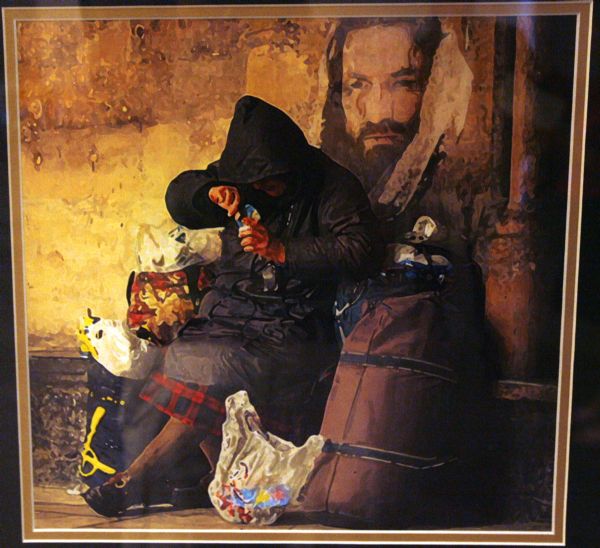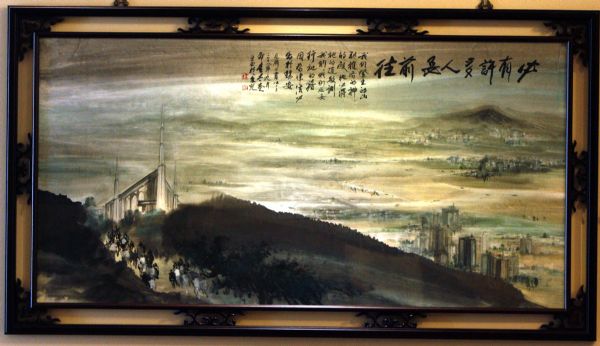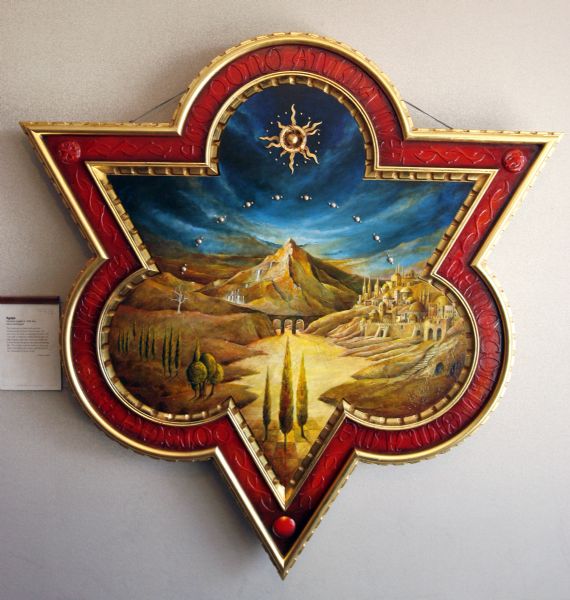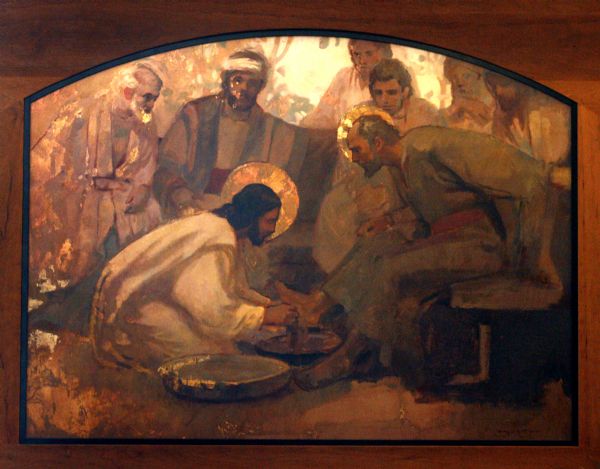This is an archived article that was published on sltrib.com in 2009, and information in the article may be outdated. It is provided only for personal research purposes and may not be reprinted.
For two months, thousands of Mormons and interested others streamed through the quiet halls and sacred rooms of the faith's newly built and soon-to-be-dedicated Oquirrh Mountain Temple. They marveled at the spare-no-expense gold-leafed mirrors, the imported-glass chandeliers, the hand-woven carpets, the granite from China, the soaring windows.
To some, though, one essential of a religious edifice was lacking: fresh visual art to express the unique beliefs of The Church of Jesus Christ of Latter-day Saints.
LDS temples, including Oquirrh Mountain in South Jordan, now use mostly prints of familiar Christ paintings from the 1960s, common in church publications, LDS homes and chapels. Sometimes the same portrait of Jesus is repeated in several rooms or hallways of the temple.
"If you see the same image over and over, no matter how great it is, after a while, your eyes stop looking," says Glen Nelson, director of the Mormon Artists Group in New York City. "It is a dulling spiritual experience."
By any measure, there are plenty of contemporary artists whose work could enhance the temple experience.
More than 1,000 Mormon artists from 44 nations entered the Church History Museum's Eighth International Art Competition, titled "Remembering the Great Things of God." Of those, 197 were chosen for display in the Conference Center in downtown Salt Lake City. There are depictions of walking in heaven, atonement, Eve's daughter, the human family tree, the flight from Egypt and Christ as "living water."
Adam Abrams' oil painting "Gethsemane" shows Jesus prostrate, hands covering his head. It is suggestive, evocative, emotion-packed and tailor-made for sacred space.
"People love to see the art in the temple," says Kathleen Bluth, interior designer for the church's Temple Department, in a news release about the competition. "It contributes to the comfort and peace they so often find during their instruction and learning there."
So why is it so hard to get new pieces in the temples?
The church built temples at such a furious pace in the 1990s that "we haven't had time to commission new art," then-LDS President Gordon B. Hinckley said at a news conference for the Boston Temple in 2000. "We are just starting that now."
Within a year of Hinckley's statement, six LDS artists were commissioned to paint landscape murals for the "World Room" of the newly reconstructed LDS temple in Nauvoo, Ill., the first such murals in decades. After that, murals began appearing in temples from New York City to Draper to Oquirrh Mountain, and the Mormon faithful responded with approval and delight.
Still, many Mormon artists and members yearn for more than landscapes. They want the temple to incorporate new images of Jesus, biblical scenes or contemporary faith. They want original art, rather than mass-produced prints.
"Art can be a powerful teacher, even more so than the spoken word sometimes," says Gary E. Smith, an Alpine artist and founding member of the Mormon Belief and Art Movement in the 1960s. "It can stay with you, can inspire you over long periods of time."
So what's the holdup?
Too Catholic, too Protestant » In the LDS Church's early days, leaders drew inspiration from the designs of more established faiths. As a young missionary in Great Britain in the 1830s, Brigham Young studied London's great cathedrals, some of whose elements were incorporated into the Salt Lake Temple.
But, in the 20th century, Mormons often stayed away from anything that seemed "too Catholic or too Protestant," says LDS artist Brian Kershisnik, who has a studio in Kanosh. "There were certain things we didn't do because other people did."
Such concerns seem to be dissipating among LDS leaders and artists. Few collect creche sets more avidly than Mormons, for example.
"My work is very Mormon and very Catholic," says Kershisnik, whose giant oil painting "Nativity" was featured prominently at Brigham Young University. A print of it is hanging in a Roman Catholic church in Logan.
"I love painting the Madonna and child, and right now I'm working on a piece about Christ being taken down from the cross," he says. "Artistically, it is becoming more acceptable to create art that is influenced by ancient Catholic work. We don't have to work against that."
But Kershisnik isn't pushing for his work to be hung in LDS temples -- although he says he and other artists would welcome the chance to do so.
"As a general church culture, we will continue to mature, and if any of my works become useful along that path, I would be very pleased," he says. "In the meantime, I have plenty to work on. It is others who will decide if what I do is relevant."
The temple is not an art gallery designed to appeal to an array of tastes. Its rituals are meant to submerge participants in an experience that educates them about eternity. Art can enrich that experience -- or detract from it.
"Artists have a hard time not trying to draw attention to themselves," Kershisnik says. "Juxtaposing imagery and worship will always yield fantastic and catastrophic results, but most will be just varying slightly around 'OK.' "
Nelson is convinced it's worth the trouble to find the best work.
"There must be some way that, in our sacred spaces, we can have artworks that are compelling without being offensive, challenging and stimulating without being distracting," he says. "Rather than display individual paintings by different artists side-by-side, the best idea may be to engage an artist to create multiple works in a series. Such thematic works would tell a powerful story and create an important atmosphere for the temple."
The deciders » For the past four years, all the art donated to or bought by the LDS Church has had to be approved first by an art committee. The panel includes church architects, curators, interior designers, artists and BYU professors.
"It's a very diverse committee," says Vern Swanson, curator of the Springville Art Museum and committee member. "And we all voice our strong opinions."
This panel accepts about 50 percent of the pieces presented to it, Swanson says, and sends them to the Presiding Bishop's office, which reduces the number by another 50 percent. The remaining 25 percent are proposed to the First Presidency, which makes the final decisions.
"We do send a few edgy pieces up, but mostly we want to create peace and serenity for the temple," he says. "We are looking for something that can add to the quality of the experience. The temple is not a place for confrontation."
Besides, those who make the decisions have a tendency not to be experimental, Swanson says. "Their typical taste is conservative, and they represent 75 percent of the people."
Some artists feel the bureaucratic process diminishes the possibilities.
"When art goes through committees with so many voices and opinions, things become kind of generic," says Smith, who worked on the Nauvoo murals and who has several works displayed in temples. "I would love to see a little more leeway, even some New Testament paintings that have a little different style or feel to them. I think people sometimes need to be challenged in their thinking."
Currently, the church commissions two new paintings per temple, but they are largely landscape murals. It recently called several painters -- including Joseph Brickey, Frank Magleby and Linda Curley Christensen -- on "art missions" to produce work for the temples. They are assigned on a temple-by-temple basis and serve for six months.
In June 2008, Christensen, who lives in Wallsburg, Wasatch County, was tapped to work on murals for the Oquirrh Mountain Temple and immediately assembled a small group of artisans with various skills and backgrounds to help. The finished murals showcased depictions of Utah's alpine mountains and granite rocks.
Swanson, too, would like to see more biblical, Book of Mormon and historical scenes.
"Of the 12,000 Mormon artists currently working, 15 percent are using postmodern techniques and 85 are using traditional," Swanson says. "But a multifigure mural is more time-consuming and expensive than a landscape."
He maintains the church is "doing a magnificent job with temple art, better than it's ever done before."
Of course, Swanson says, "we always want it to be better."
pstack@sltrib.com" Target="_BLANK">pstack@sltrib.com
Where » LDS Conference Center
When » Monday to Saturday, 10 a.m. to 7 p.m.; Sunday, 11 a.m. to 7 p.m., through Oct. 11
Admission » Free and open to the public
When » Aug. 21--23
Admission » By ticket only



















